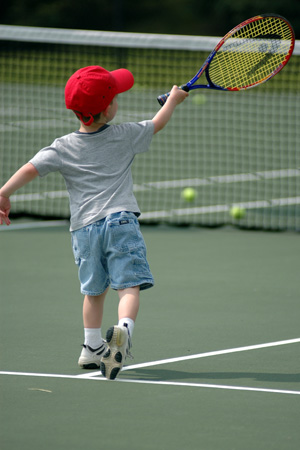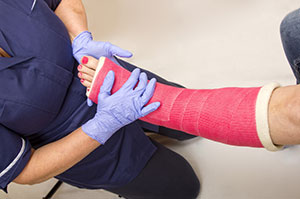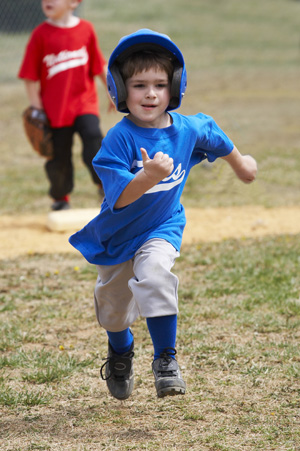Does my child have weak bones?
On one hand, young er bones are more flexible and resistant to injury
than older, brittle bones. Young bones can stand more stress due to
the plasticity and porous nature of growing bone. But occasionally
the bone
may fracture, or break. Even multiple fractures are not necessarily
a sign of weak bones. Fractures such as in the wrist, forearm or elbow
are most common of all the fractures we see in children because they
attempt to break their fall with their hands and wrists. Very few children
have abnormally weak bones. Some of these children may have Osteogenisis
Imperfecta, also known as Brittle Bone Disease. Many of these children
have a fracture in the first year or two of life, and low stress injuries
may cause fracture. A new test called bone densitometry is used of
to
determine risk of fracture.
er bones are more flexible and resistant to injury
than older, brittle bones. Young bones can stand more stress due to
the plasticity and porous nature of growing bone. But occasionally
the bone
may fracture, or break. Even multiple fractures are not necessarily
a sign of weak bones. Fractures such as in the wrist, forearm or elbow
are most common of all the fractures we see in children because they
attempt to break their fall with their hands and wrists. Very few children
have abnormally weak bones. Some of these children may have Osteogenisis
Imperfecta, also known as Brittle Bone Disease. Many of these children
have a fracture in the first year or two of life, and low stress injuries
may cause fracture. A new test called bone densitometry is used of
to
determine risk of fracture.
"My child has a broken bone!"
The most common fractures or breaks involve the wrist, forearm or elbow in children. Less common fractures include, the shoulder, lower leg and upper leg and other bones. Some fractures may be treated with a short or long cast. Some may require surgery and pinning before casting. Other more serious fractures may require "open reduction" where an incision is made in the skin to realign the bones correctly, sometimes with the aid of fixation devices like metal rods, plates or screws.
 Because
fractures are trauma, chances are you will quickly end up in the nearest
emergency room. There, the hospital will have on staff an orthopedic surgeon
who will stabilize your child and provide the necessary emergency care.
In some cases, in minor injuries, the fracture will be treated in the
emergency room. In cases involving complex injury or multiple fractures,
emergency surgery may be required. In other cases, such as involving ligaments
or tendons, you may be referred to an orthopedic surgeon's office the
following day.
Because
fractures are trauma, chances are you will quickly end up in the nearest
emergency room. There, the hospital will have on staff an orthopedic surgeon
who will stabilize your child and provide the necessary emergency care.
In some cases, in minor injuries, the fracture will be treated in the
emergency room. In cases involving complex injury or multiple fractures,
emergency surgery may be required. In other cases, such as involving ligaments
or tendons, you may be referred to an orthopedic surgeon's office the
following day.
Again, once the initial emergency care is provided, we recommend that when possible, consult an orthopedic surgeon who is specialized in pediatric sports medicine in order to achieve the best possible outcome for your child or teen.
"My child is has bowed legs" or "My child has knock knees"
Bowleggedness is common from the age that children begin to walk up until about the age of 18 months. After that time, knocked-kneed appearance usually predominates and becomes most marked by age 3 or 4 years. Studies show that some children could get early arthritis or knee pain as an adolescent if deformities are left untreated. The chance of later problems may be related to the severity of the deformity. Other children may have a problem with the cartilage around the knee or a problem with bone mineralization. Screening X-rays may be needed to assess the deformity.
"My child walks like a duck" or "My child points his toes inward"
 Intoeing, or walking with the feet turned inward, is sometimes called "pigeon-toed." Walking with the feet turned out, may be a variant
of normal, or may represent a treatable disorder. Many children have these
rotational deformities, which correct as they get older. The twist may
be in the femur, or the large bone of the leg at the hip, the tibia bone,
which is the bone between the knee and the ankle on the inside of the
leg, or it may be the result of a foot deformity. Very few cases represent
a muscular or neurological problem. Your pediatric orthopedist may want
to conduct a rotational profile on your child which will consist of watching
them walk and moving the hips and legs to observe certain angles –– a
painless and quick test.
Intoeing, or walking with the feet turned inward, is sometimes called "pigeon-toed." Walking with the feet turned out, may be a variant
of normal, or may represent a treatable disorder. Many children have these
rotational deformities, which correct as they get older. The twist may
be in the femur, or the large bone of the leg at the hip, the tibia bone,
which is the bone between the knee and the ankle on the inside of the
leg, or it may be the result of a foot deformity. Very few cases represent
a muscular or neurological problem. Your pediatric orthopedist may want
to conduct a rotational profile on your child which will consist of watching
them walk and moving the hips and legs to observe certain angles –– a
painless and quick test.
